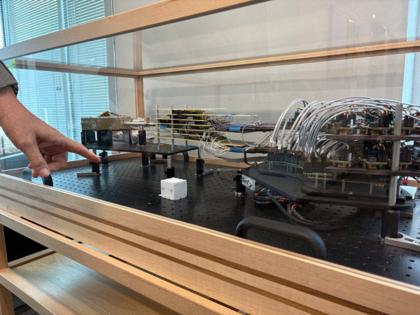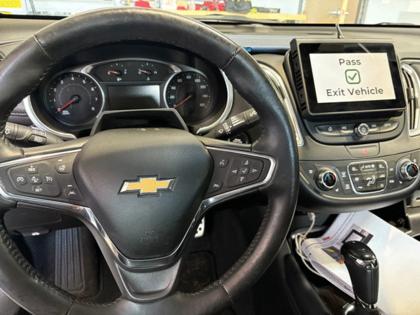Ten years after prototype, anti-drunken driving tech ready for rollout
Published in Automotive News
LEESBURG, Virginia — Ten years after unveiling a prototype, a key public-private research effort is taking a major leap toward getting its advanced alcohol detection technology into the hands of the country's top auto manufacturers.
"We've converted a wild, audacious idea that everybody thought would fail — people laughed us out of the room — into a viable technology suite," said Rob Strassburger, president and CEO, Automotive Coalition for Traffic Safety.
"I might just break down and start crying," he said of the 10th anniversary. "This has been a very challenging effort, and a very interesting effort, technologically and scientifically. But we have never lost sight of why we're doing this."
Strassburger's group is home to the Driver Alcohol Detection System for Safety project, or DADSS. The parentally nicknamed project has worked with Mothers Against Drunk Driving, the federal government and automakers in an effort to develop technology solutions to someday end the deadly plague of drunken driving on American roads.
DADSS, according to Strassburger, is at a critical and exciting juncture. The project is in the long-planned process of licensing some technology out to vehicle and parts manufacturers, who will be able to study the sophisticated infrared light-based sensors, integrate them into future vehicles and improve upon the designs.
"We're at an inflection point where we should not hang on to this technology any longer," Strassburger said in an interview. He announced the move toward licensing at a MADD event in September: "We should be handing off to product integrators, OEMs and safety system suppliers, and that's exactly what we're doing."
The latest phase comes as the National Highway Traffic Safety Administration, the nation's top road safety regulator, weighs the implementation of a 2021 congressional directive to mandate anti-drunken driving technology in all new passenger vehicles. That directive was borne out of a bipartisan push and named for a Michigan family of five killed in a drunken-driving crash in 2019.
The agency has not yet drafted rules on the topic, missing lawmakers' stated target for implementation. Advocates said last month, however, that they have renewed optimism and excitement.
They cited encouraging conversations with the Trump administration and an announcement from the Insurance Institute for Highway Safety that the group will soon consider impaired driving prevention tech as part of its influential vehicle safety ratings.
"Once systems like DADSS are out there, then that's what you're going to need in order to get the top rating," said Chuck Farmer, vice president of research at IIHS.
The law does not prescribe one specific technology for the NHTSA regulations. It left the door open for camera-based driver monitoring systems, exterior cameras and sensors, alcohol detection systems or others. Beyond DADSS, MADD pointed to several auto suppliers that have worked on applicable technologies, including Seeing Machines, Smart Eye AB, Valeo, Bosch and Magna International Inc.
Tech advances
The DADSS project is a collaboration between NHTSA and ACTS, the nonprofit Strassburger leads. The effort officially began in 2008. Since then, DADSS engineers have worked on developing detection systems that are both highly accurate and minimally invasive — and that would someday be widely available across the auto industry.
DADSS has pursued two technology tracks in its 17 years of research: breath-based and touch-based. Both rely on infrared spectroscopy — essentially shining lasers at the breath or skin — to determine the concentration of alcohol molecules.
The breath-based systems, for now, are further along in development. They include an "active" type that requires a weak-but-directed puff of air toward a sensor that quickly measures a driver's blood-alcohol levels. The sensor can be built into a vehicle's steering column and does not require a plastic attachment tube, like classic breathalyzers. DADSS has already commercialized that system.
Crucially for industry adoption, DADSS has also developed a passive system that captures ambient breath from the driver and makes a reading without requiring any change to behavior. The reading is completed in the time it takes to enter a vehicle and put on the seat belt.
That less invasive system is in the final stages of commercialization. DADSS has begun sending out reference designs and engineering kits to manufacturers, including drawings, bills of materials and other documentation for auto companies to integrate third-party systems into their vehicles, or manufacture the technology themselves.
He likened the reference design to the classic USB plugs most people are familiar with. Many companies manufacture USB ports and cables, but there are widely used parameters.
The breath-based system is 99.9997% accurate, according to Strassburger, up from the 90s or high 80s a decade ago when the group's prototype launched. He said the final 0.0097% was the hardest to achieve, but that DADSS engineers are well attuned to concerns from consumers and the auto industry that their vehicles could register false positives.
The group has also focused on other important factors that would make the technology commercially viable, like making it more resilient to temperature extremes in vehicle cabins, sturdier for bumps and shocks that happen during driving, and smaller so it can fit easily — and cheaply — into vehicles.
"This must be able to be mass produced in automotive quantities, and live in a car for the life of that car, which we set at, like, 187,500 miles," said Strassburger, a 1981 engineering graduate from the University of Michigan who has worked in the auto industry since then.
He estimated the current cost of the passive breath-based system at $200 to $250 per vehicle, and predicted the cost would come down with greater scale in production.
"One of the principal reasons why we chose infrared spectroscopy is that the development arc ultimately leads to a system on a chip. We need a lot more investment to get to that point, but this (system) will all be a little computer chip someday," Strassburger said.
DADSS has also made significant advances with its touch-based technology since the project's inception. The system used to be close to the size of a full vehicle dashboard, requiring dozens of wire bundles connected to computer boards and sensors. Now the technology fits into a package roughly the size of a small jewelry box.
That system, while promising, is still not ready for commercialization. Strassburger said it also faces an uncertain future if NHTSA stops funding DADSS.
The project had a budget of about $14 million last year, up from $1 million in its first year. The total investment in the project since its inception has been approximately $167 million, with about 75% of the funding coming from the federal government and 25% from automakers.
Strassburger acknowledged that DADSS was never meant to be a permanent initiative and is searching for an industry partner to take over the ongoing development of the touch-based system. He said, however, that has been a challenge given headwinds in the auto industry, citing competition from China, tariffs and sweeping regulatory changes under the Trump administration.
"I would love to find an industry partner. And if I can, fantastic. But I also understand that the government itself has its challenges," Strassburger said.
Is the world ready?
The Alliance for Automotive Innovation, the industry's top lobbying group, has been cautious about the deployment of anti-drunken driving technology in vehicles before the drivers are ready.
"How the rules and regulations get implemented will impact consumer acceptance. Consumer acceptance is required for the technology to have the most impact and save the most lives," the group wrote in a 2024 one-pager when NHTSA was seeking public comment on potential rules.
"Nobody should ever drive while impaired. Ever. Impaired driving weighs heavily on automakers," the alliance said in a statement. “Automakers continue to make major investments in research, development and testing of drunk and impaired driving technology as well as crashworthiness and crash avoidance systems to help improve safety on the roads."
He continued: “For more than a decade, this has included a major investment in the DADSS program. With support from NHTSA and others in the safety community, the auto industry has helped advance the development of this lifesaving technology."
The lobbying organization has conducted consumer surveys on the topic but has yet to publish its latest findings. Surveys from other groups, like the IIHS and academic researchers, suggest that two-thirds to three-quarters of U.S. drivers support the inclusion of technology in vehicles to prevent impaired driving.
Farmer, of IIHS, also pointed to an August 2025 study on driver attitudes toward Subaru Corp.'s Driver Focus driver monitoring system. Study participants expressed mostly positive sentiments about the technology.
"Most drivers agreed that they would want the system again (70%), and those who drove with it on agreed it made them a safer driver (64%) and helped them avoid distractions (63%). Receiving too many alerts and annoyance were the top reasons cited by the 4% of drivers who turned the system off under their profile settings," the study said.
Stephanie Manning, MADD's head of government affairs, acknowledged some of the concerns she hears about most with the DADSS technology and other systems: data privacy, false positives and cost.
"I think there are bigger issues that need to be discussed regarding consumer privacy. I'm an advocate for consumer privacy. I agree that we all have an unsettled feeling about the data that is shared about us and our loved ones through lots of different mechanisms every single day," Manning said.
But she added: "Anti-drunk driving technology is not going to make that any better or any worse. It is a neutral addition that is going to save more than 10,000 lives every year and prevent hundreds of thousands of serious injuries. We don't want anyone's data to be collected, shared, stored or sold. This is purely a prevention tool."
On false positives, Strassburger noted that the DADSS technology can — and perhaps should — be conservatively set so it does not capture trace amounts of alcohol. He also noted that the technology can take multiple readings.
"Nothing's perfect," he said. "There will be false positives and there will be false negatives. In our testing, we have set up the sensor to minimize false positives, and with that, we project an effectiveness in the 70% range, meaning a 70% reduction in drunk driving fatalities."
Strassburger also noted that DADSS has tested its technology with vehicle fleet partners in Virginia, Connecticut, Washington and Maryland. He said that was "invaluable" for improving the technology and finding edge cases that improperly trigger positive readings, like monk fruit sweeteners and certain vape cartridges.
On cost concerns, Manning pointed to the IIHS safety rating announcement and the potential for a NHTSA mandate on the horizon. "Cost will come down significantly. And, you know, OMB and DOT set a price on a human life," she said, referring to the latest $13.7 million value of a statistical life figure.
Manning added: "When you look at the number of people killed and seriously injured, there's no question that this rule should move forward."
Strassburger expressed a similar sentiment about the technology. He has continued leading the DADSS effort despite battling Stage 4 cancer.
"Everybody in the last couple of years has asked me, 'Well, Rob, why haven't you retired?'" he said. "And I tell people: It's because I've been at this so long, and because there's so much at stake here."
©2025 www.detroitnews.com. Visit at detroitnews.com. Distributed by Tribune Content Agency, LLC.











Comments